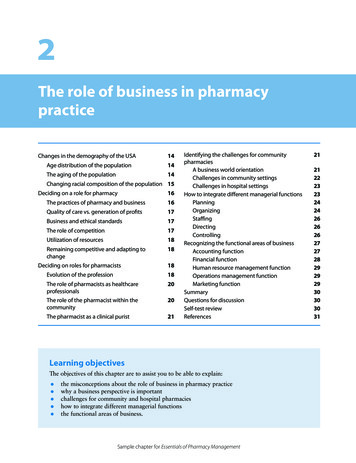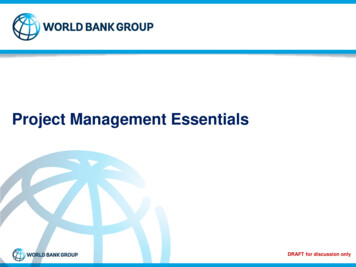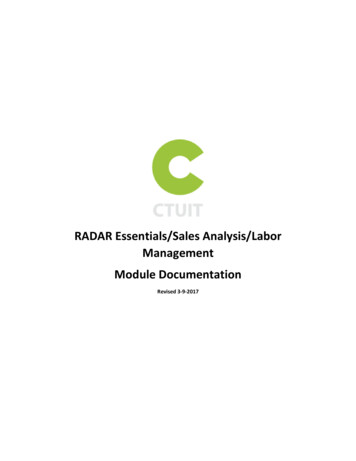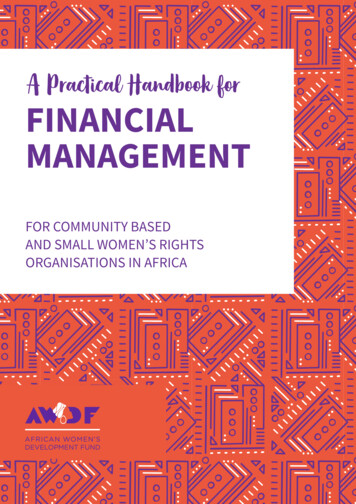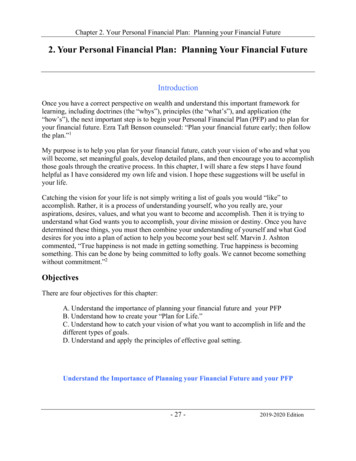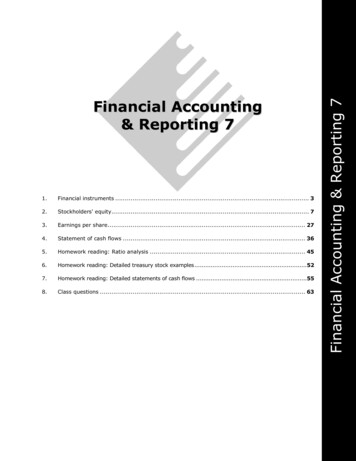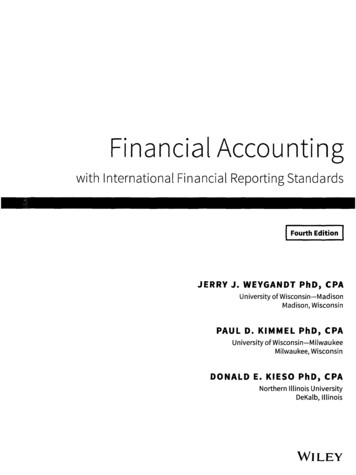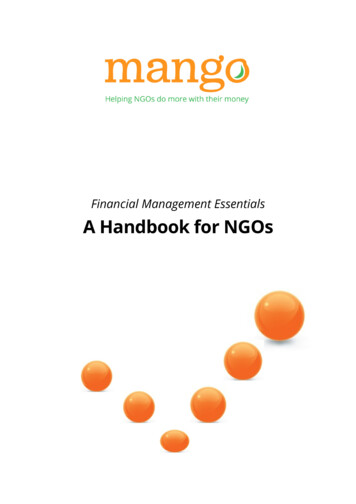
Transcription
Financialinancial Management EssentialsA Handbook for NGOs
Financial management essentialsA handbook for NGOsProduced by Terry Lewis for Mango (Management Accounting for Non-governmental Organisations)Chester House, 21-27 George Street, Oxford OX1 2AU Phone 44 (0)1865 423818 Fax 44 (0)1865 423560 E-mail training@mango.org.uk Website: www.mango.org.ukRegistered charity no. 1081406Registered company no. 3986178Revised October 2017These materials may be freely used and copied by development and humanitarianorganisations for capacity building purposes, providing Mango and authorshipare acknowledged. They may not be reproduced for commercial gain.Mango is an award-winning UK-based charity which provides financial management training, consultancy andfree resources for humanitarian and development non-profit organisations.
Table of contentsGlossary of financial termsi1 OVERVIEW OF FINANCIAL MANAGEMENT 1Foundations for effective NGO work‘Two golden rules’So what is financial management?The financial management processWhy is financial management important?Who is responsible for financial management?2 GETTING ORGANISEDSeven principles of financial managementFour building blocks of financial managementTools of financial managementSystems designFinancial and management accountingThe Chart of AccountsCost centresCost structuresFinancial policies and proceduresThe finance manualWork planning3 FINANCIAL PLANNINGThe financial planning processWhat is a budget?Who is involved in the budgeting process?Preparing budgetsWhat does the budget show?Three key budgetsActivity-based budgetingTwo important budgeting toolsBudgeting for central support costsSummarising and consolidating budgetsThe Phased budgetCreating budgets for donor agenciesMultiple donor–funded 1343537394046506062646568714 UNDERSTANDING ACCOUNTSWhy keep accounts?Accounting methodsWhich accounting records to keepSupporting documentationBank book basicsPetty cash bookFull bookkeeping systemsWhat is a trial balance?What are financial statements?What is depreciation?Accounting for shared costs5 FINANCIAL REPORTSWho needs financial reports?What are the annual accounts?Interpreting financial statementsRatio analysis: quick reference formulasManagement reportingThe cashflow reportThe budget monitoring reportForecast reportsAnalysing budget monitoring reportsVariance analysis techniquesAction planningReporting to donorsPresenting financial reportsReporting to beneficiariesSummary: Twenty questions6 SAFEGUARDING YOUR ASSETSManaging internal riskFour actions for internal controlDelegated authoritySeparation of dutiesCash controlPhysical controlsThe reconciliation processChecking accounting recordsThe 3 Ps of Procurement Mango 3144
7 MANAGING AUDITWhat is an audit?Internal auditExternal auditDonor (or project) auditWhat does the auditor need?Summary8 FRAUD AND CORRUPT PRACTICESWhat is fraud?Top tips on the warning signs of fraudHow to deal with fraudWhat is corruption?Bribery and the NGO sectorZero tolerance approach to 65167168175APPENDICES Mango 2017
FINANCIAL MANAGEMENT ESSENTIALS FOR NGOSGlossary of financial termsAccountA record of monetary transactions, either recorded in abook designed for the purpose or entered onto acomputer file.Account codeA unique numerical code or short name assigned toeach type of financial transaction, to separately identifythem in accounting records. Also used in budgets andfinancial reportsAccounting periodA specified time period for recording and reportingfinancial activity, eg one year, one quarter or onemonth.AccrualAdjustment made at the end of an accounting period torecognise expenses that have been incurred during theperiod but for which no invoice has yet been received.Accumulated fundsMoney, or equipment, that we build up year by year asa result of not spending all our income. Often referredto as reserves.Acid testThe ratio achieved by dividing Current Assets (excludingstocks) by Current Liabilities. It tells us if theorganisation has sufficient funds to pay off its debtsimmediately.AllocationThe process of sharing direct costs between two ormore cost centres in the accounts in proportion toactual or estimated use. Eg where the costs of using ashared vehicle for project work are allocated accordingto the number of kilometres travelled. Income can alsobe allocated.ApportionmentThe process of sharing indirect costs between two ormore cost centres in proportion to the estimatedbenefit received. Eg sharing Director salary on the basisof full time equivalent staff numbers.AssetSomething we own or have a claim on others which is ofvalue to the organisation. Examples include cash,equipment and loans to staff. See also Fixed Assets andCurrent Assets.AuditA formal check on accounting records by anindependent person (auditor). Mango 2017i
FINANCIAL MANAGEMENT ESSENTIALS FOR NGOSAudit trailThe ability to follow the journey of any reportedtransaction through an organisation’s accountingsystems.AuthorisationThe process of approving transactions, normally thedecision to purchase or make expenditure.Authorisation by a budget holder is a way of confirmingthat spending is appropriate and in line with thebudget.Back donorThe original source of funds channelled through anagency (such as an international NGO) to animplementing partner. The agency must report back tothe original donor to account for the use of the fundsby the partner.Balance sheetA summary of the financial position of an organisationat a particular date, showing the assets owned by theorganisation and the liabilities (or debts) owed toothers. Also known as Statement of financial position.Bank bookAn accounting register which records receipts andpayments transactions passing through a bank account.Also known as a cashbook or a cash analysis book. Canbe held in a physical book format or in a computer file.Bank reconciliationThe process of comparing the entries and ending cashbalance in the cashbook with the bank statement forthe same period, for the purpose of spotting anydifferences. It provides an important check on thecompleteness and accuracy of the cashbook entries.BudgetA best estimate of the amount of money that anorganisation plans to raise and spend for a set purposeover a given period of time.Budget holderThe individual who holds the authority, and has theresponsibility for managing, a budget for a specifiedactivity, project, programme, department ororganisation.Burn rateExpressed as a percentage, the amount of a grant orbudget used up so far. Also known as Grant or BudgetUtilisation ratio.Capital expenditureExpenditure on equipment, property and other fixedassets of high value which will be used to supportactivities over more than one accounting period.Capital fundAccumulated funds and reserves held in the form ofequipment and property.ii Mango 2017
FINANCIAL MANAGEMENT ESSENTIALS FOR NGOSCashbookAn accounting register which records receipts andpayments transactions passing through a bank or cashaccount. Also known as a bank book or a cash analysisbook. Can be held in a physical book format or in acomputer file.Cash reconciliationComparing the physical cash count to the expectedbalance in the petty cash book on a particular date.CashflowThe difference between cash received and cash spent ina period.Cashflow forecastA report that shows the expected timing of cashreceipts and payments for the next 3-6 months (orlonger).Chart of accountsA list of all the accounts codes and cost centre codesthat are used in an organisation’s accounting system,with a description of each.Core costsCentral support costs shared by many projects. Alsoknown as operating overheads.Cost centreA way of distinguishing between different activities orprojects to define where costs are incurred or income is‘earned’. Cost centres are closely linked to the conceptof budget-holders.CreditorAnyone the organisation owes money to.Current assetsCash and other short-term assets in the process ofbeing turned back into cash – eg debtors. They can, intheory, be converted into cash within one year.Current liabilitiesAmounts owed to others (eg unpaid suppliers’ bills,bank overdraft) which should be paid in the next 12months.Current ratioA measure of liquidity obtained by dividing CurrentAssets by Current Liabilities. It tells us if theorganisation is able to pay off its debts within 12months.DebtorAnyone who owes money to the organisation.DepreciationA proportion of the original cost of a fixed asset,representing the loss in value due to use, which isinternally charged as an expense to the organisation.Designated fundsPart of the unrestricted general reserves which havebeen set aside for a particular purpose at the discretionof the Board.Direct costA cost which can be specifically allocated to an activity,department or project. Mango 2017iii
FINANCIAL MANAGEMENT ESSENTIALS FOR NGOSDonation in kindWhere a grant or contribution to a project is made inthe form of goods or services, rather than a cashdonation.Double fundingWhere a project or activity has restricted funding frommore than one source and which exceeds the budgetneeded to complete the activity.Double entrybookkeepingThe method of recording financial transactions wherebyevery item is entered twice (once as a debit entry andonce as a credit entry) to recognise there are alwaystwo sides or parties in every transaction – a giver and areceiver.Exceptions reportA short narrative report which highlights significantvariances or areas for concern to accompanymanagement reports.External auditA review of the year-end financial statements carriedout by a professionally qualified and legally registeredauditor resulting in an opinion about whether they givea true and fair view of the financial position andassociated records.Financial accountingThe process of recording, classifying and summarisinghistorical financial data, resulting in financialstatements.Fixed assetAn item of high value owned by the organisation for useover a long period, eg office equipment, vehicles andbuildings.Fixed assets registerA schedule of an organisation’s equipment andproperty, recording details of purchase date, value,location, etc.FraudIntentionally lying or cheating to gain an advantage orto cause someone else to make a loss.Fund accountingAccounting for spending on projects according to thesource of the donated funds.Funding gridAn internal planning tool which provides an overview ofwhich donor fund is paying for what part of a projectbudget.General ledgerThe main accounting record where double-entrybookkeeping is used. See also Nominal ledger.General fundsUnrestricted reserves which have not been set aside fora particular use and which may be used to support anyof the organisation’s objectives.iv Mango 2017
FINANCIAL MANAGEMENT ESSENTIALS FOR NGOSGood received note(GRN)Supporting document which accompanies deliveries ofgoods, signed by the person receiving the delivery toacknowledge the goods are received undamaged andas stated on the packing note.ImprestA type of cash float, set at an agreed level, which istopped up by the exact amount spent since it was lastreimbursed to bring it back to its original level.Income & expenditureaccountSummarises income and expenditure transactions forthe accounting period, adjusting for transactions thatare not yet complete or took place in a differentaccounting period. Also known as Statement of financialperformance, Profit and Loss account or IncomeStatement.Indirect costA cost which cannot be specifically assigned to oneactivity, department or project, eg the fee for the annualaudit. Usually shared out (apportioned) betweenprojects on a pre-agreed basis.In-kind donationSee Donation in kind.Journal entryAn entry in the books of account which covers a nonmonetary transaction – eg for recording a donation inkind or an adjustment to correct a recording error.LiabilitiesAmounts owed by the organisation to others, includingoutstanding invoices, unspent restricted grants andloans.LiquidityThe level of cash and assets easily convertible to cashcompared to demands on the available cash, eg to paybills.Liquidity ratioA measure of liquidity obtained by dividing debtors,cash and short-term investments by current liabilities.Management accountingProviding financial information to managers for thepurposes of planning, decision-making and monitoringperformance.Net assetsTotal assets minus total liabilities, the net worth orequity of an organisation.Net book value (NBV)Cost of a fixed asset less the total cost of depreciationto date.Net current assetsFunds available for conducting day-to-day operations ofthe organisation, defined as current assets less currentliabilities. Also known as working capital. Mango 2017v
FINANCIAL MANAGEMENT ESSENTIALS FOR NGOSNominal accountA ‘page’ or ‘container’ in the nominal ledger forrecording every type of financial transaction likely tooccur in an organisation. A complete list appears in theChart of Accounts, each with a unique nominal code.Nominal ledgerA book or computer programme which holds details ofeach of the nominal accounts. Also known as theGeneral ledger.OrganogramOrganisation chart showing the management anddepartmental structure of the organisation.Payment voucherAn internal document completed for each payment tocapture payment information and evidence ofauthorisation. Supporting documents are attached to it.Petty cash bookThe day-to-day listing of petty cash (ie small cashamounts) transactions.PrepaymentsAmounts paid in advance at a particular accountingperiod, eg office rent paid for the next three months.ProcurementThe process of purchasing goods and services includingrequisition, supplier selection, purchase order, receivinggoods and payment.Quarter / quarterlyThree months of the accounting year
Budget A best estimate of the amount of money that an organisation plans to raise and spend for a set purpose over a given period of time. Budget holder The individual who holds the authority, and has the responsibility for managing, a budget for a specified activity, project, programme, department or organisation. Burn rate Expressed as a percentage, the amount of a grant or budget used up so .
